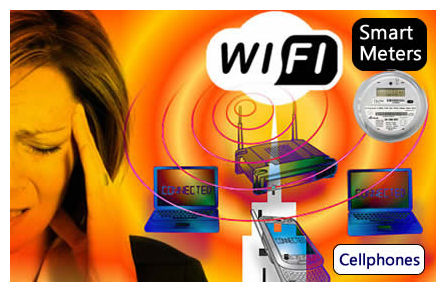
© PreventDisease.com
Neurosurgeon and researcher Dr. Leif Salford has conducted many studies on radio frequency radiation and its effects on the brain. Dr. Salford called the potential implications of some of his research "terrifying." Some of the most concerning conclusions result from the fact that the weakest exposure levels to wireless radiation caused the greatest effect in causing the blood brain barrier to leak.
Since he began his line of research in 1988, Dr. Leif Salford and his colleagues at Lund University Hospital in Sweden has exposed over 1,600 experimental animals to low-level radiation. Their results were consistent and worrisome: radiation, including that from cell phones, caused the blood-brain barrier--the brain's first line of
defense against infections and toxic chemicals--to leak.
Researchers in 13 other laboratories in 6 different countries had reported the same effect, but no one had proven whether it would lead to any damage in the long term. In a study published June 2003 in
Environmental Health Perspectives, Salford's team repeated the experiment on 32 additional animals, but this time waited eight weeks before sacrificing them and examining their brains. In those animals that had been exposed to a cell phone, up to two percent of the neurons in all areas of the brain were shrunken and degenerated.
Salford, chairman of the Department of Neurosurgery at his institution, called the potential implications "terrifying." "We have good reason to believe," he said, "that what happens in rats' brains also happens in humans." Referring to today's teenagers, the study's authors wrote that "a whole generation of users may suffer negative effects, perhaps as early as in middle age."
Dr. Devra Davis, author of "Disconnect" explains the science of cell phone radiation in a very comprehensive way. For example she shows photos of two cells, one whose DNA has been damaged by "gamma" radiation (which is what was emitted in Hiroshima) and another cell damaged by low level pulsing non ionizing radiation (from a cell phone). Both cells look very damaged compared to a normal cell; but she even goes on to say the DNA from the cell exposed to the cell phone radiation looks worse. She also discusses the campaign to discredit reputable scientists and their studies--some of these reputable studies having been around since 1972 (Frey).
In May of 2011, the World Health Organization official recognized that wireless radiation such as emitted by "smart meters" is a possible carcinogen. After decades of corporately-funded, biased research being held up as "industry-standard", there are hundreds of independent peer-reviewed scientific studies now showing there is a clear health hazard with technology emitting wireless radiation in the range that "smart meters" do. Meanwhile, tens of thousands of people with a "smart meter" installed, have contracted illness, insomnia, rashes, headaches, and worse. And many have been forced to leave their homes entirely, due to health effects. What's more, in apartment buildings where 30+ "smart meters" are installed in a single electrical room, the dangers are even higher. There have been no long-term health studies done on this high level of Electromagnetic Radiation.
PBS Interview with Dr. Keith Black (neurosurgeon) regarding WHO's classification of RF Elecctromagnetic radiation as a 2b possible carcinogen. "We haven't had any good studies in the pediatric population. A child's skull is much thinner. . . .and the amount of radiation that goes into the pediatric brain is much higher than in an adult. So we should be cautious with how we allow our children to use a cell phone. They're going to be the ones that not only are going to use it at a much younger age but at a much longer duration."
Let's start connecting the dots and end this madness to our health and the health of future generations.
Marco Torres is a research specialist, writer and consumer advocate for healthy lifestyles. He holds degrees in Public Health and Environmental Science and is a professional speaker on topics such as disease prevention, environmental toxins and health policy.
Thank you very much for the information here. The disconnect between studies and the telecommunication's industry is the missing science in safety standards including the FCC. They use the Specific Absorption Rate(SAR) which admits people are absorbing RF energy but they only dealt with the end use device and not the rest of the wireless circuit. Here is the device used in the SAR, it is a plastic head for testing cell phones. [Link]
Smart Meters and Wi-Fi were considered safer because the computers and meter aren't held against the head. Notice what is missing in the SAR? They thought a small part of the skull was heated by the phone, they left out towers or antennas communicating with the phone and hitting people from head to toe. Wi-Fi left out the routers smothering classrooms with children in the wireless circuit. Smart Meters left out relays, routers and collectors radiating 100s of sq miles to communicate with the meters. That creates a biological killing field over 100s of sq. miles.
They use thermal and non thermal references because they left out the frequencies or electricity of biological systems in a frequency equation. As soon as you incorporate the missing information it substantiates the biological reporting plus much more. It radiates buildings causing molecular earthquakes, induces a static charge in volatile areas, kills trees, fish spawning, induces pacemakers, health monitoring equipment, etc. [Link]
The American Academy of Environmental Medicine reported on Smart Meter dangers. [Link]The dangers of the frequencies is now lectured in medical education for education credits medical professionals require for licensing. [Link]
Fires from unqualified installers changing meters under electrical load endangers every building. [Link]
Frequencies causing mutation after eggs radiated. [Link]
Thanks again for your work on reporting the truth of these dangers, the frequencies are illegal as applied now or extinction is the reality. There are reasons we wire devices and it is the missed global economy.